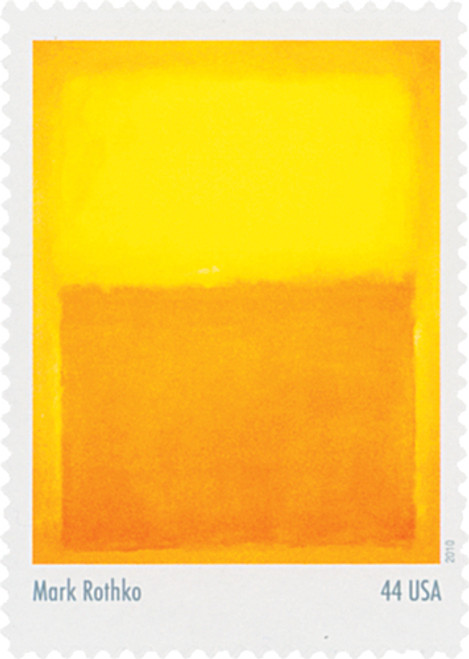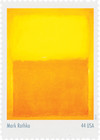
2010 44c Abstract Expressionist: Mark Rothko
# 4444c - 2010 44c Abstract Expressionist: Mark Rothko
$3.00 - $3.75
U.S. #4444c
Abstract Expressionists
Abstract Expressionists
Issue Date: March 11, 2010
City: Buffalo, NY
Printing Method: Lithographed
Perforations: Serpentine Die Cut
City: Buffalo, NY
Printing Method: Lithographed
Perforations: Serpentine Die Cut
Mark Rothko – Orange and Yellow
For Mark Rothko (1903-70), “a painting is not a picture of an experience, but is the experience.” Rothko created this feeling by removing recognizable symbols and figures from his works and communicating intense emotions through color.
Mark Rothko had his first “experience” with art at the age of 20, watching a class sketch a live model. Studying under renowned artists Arshile Gorky, Max Weber, and Milton Avery, Rothko discovered that painting was a form of emotional and religious expression. Other early influences on Rothko’s style include Surrealist Paul Klee, and German Expressionist Franz Marc.
Rothko developed his signature style in the mid-1940s, realizing that he could convey stronger emotions through his paintings by placing emphasis on emotional expression through color, rather than figure. For Rothko, creating these massive paintings was a religious experience. His 1956 oil painting, Orange and Yellow, is a cheerfully moving piece that leaves many of its viewers moved by the overwhelming intensity.
Rothko’s legacy continues, as his style influenced many art schools to teach color field painting (creating large areas of flat color with no emphasis on brushstrokes). In 2007 one of Rothko’s paintings sold for $72.8 million, breaking the record selling price of any post-war painting at public auction.
U.S. #4444c
Abstract Expressionists
Abstract Expressionists
Issue Date: March 11, 2010
City: Buffalo, NY
Printing Method: Lithographed
Perforations: Serpentine Die Cut
City: Buffalo, NY
Printing Method: Lithographed
Perforations: Serpentine Die Cut
Mark Rothko – Orange and Yellow
For Mark Rothko (1903-70), “a painting is not a picture of an experience, but is the experience.” Rothko created this feeling by removing recognizable symbols and figures from his works and communicating intense emotions through color.
Mark Rothko had his first “experience” with art at the age of 20, watching a class sketch a live model. Studying under renowned artists Arshile Gorky, Max Weber, and Milton Avery, Rothko discovered that painting was a form of emotional and religious expression. Other early influences on Rothko’s style include Surrealist Paul Klee, and German Expressionist Franz Marc.
Rothko developed his signature style in the mid-1940s, realizing that he could convey stronger emotions through his paintings by placing emphasis on emotional expression through color, rather than figure. For Rothko, creating these massive paintings was a religious experience. His 1956 oil painting, Orange and Yellow, is a cheerfully moving piece that leaves many of its viewers moved by the overwhelming intensity.
Rothko’s legacy continues, as his style influenced many art schools to teach color field painting (creating large areas of flat color with no emphasis on brushstrokes). In 2007 one of Rothko’s paintings sold for $72.8 million, breaking the record selling price of any post-war painting at public auction.








